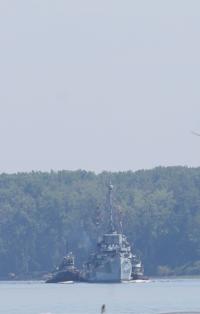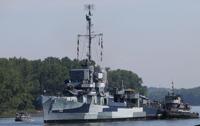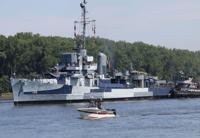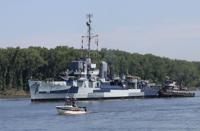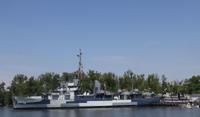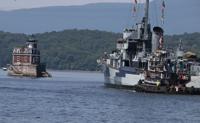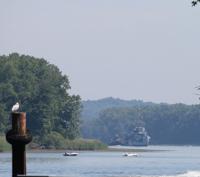HUDSON — The USS Slater destroyer escort ship headed out from its snow dock on the Hudson River in Albany at about 8 a.m. Sunday and passed by the Twin Counties, including Hudson’s waterfront, three hours later as it traveled to Caddell Shipyard in Staten Island for continued restoration work.
The Slater was escorted down the river by the Sarah D. and Nathan G. tugboats.
The ship is the last one afloat of 563 destroyer escorts during World War II that battled Nazi U-boats on the Atlantic protecting convoys personnel and material while also defending naval task forces against submarine and in the kamikaze attacks in the Pacific, according to the Destroyer Escort Historical Museum in Albany.
The destroyer has undergone an extensive restoration that has returned the ship to her former glory, according to the museum.
The ship is a Cannon-class destroyer escort built as a result of a critical shortage of anti-submarine vessels in the Atlantic at the outset of World War II. At the request of the British Navy, American designers developed a new type of warship, based on the British Hunt-class destroyer, which combined heavy anti-submarine and anti-aircraft weapons with the latest electronic equipment for detecting enemy vessels. In addition, destroyer escorts were designed to be maneuverable, high speed, long ranged vessels that could be built quickly due to their all-welded construction, according to the museum.
Commissioned in May 1944, the Slater was assigned to Atlantic convoy duty. Following the Allied victory in Europe on May 8, 1945, the SLATER was sent to the Pacific for further convoy duty, passing through the Panama Canal on June 28. The ship remained on duty in the Philippines after the war’s end, transferring to Green Cove Springs, Florida, in April 1946 for deactivation. The SLATER was decommissioning in May 1947, according to the museum.
“The Slater was transferred to Greece on March 1, 1951 as AETOS 01 under the Military Defense Assistance Program,” according to the museum. “Under this program, it was expected that if Communist forces invaded Western Europe, escort vessels given to European NATO nations would be available to assist in convoy escort and antisubmarine warfare. The ship began Greek service in July 1951. For the next forty years, the AETOS completed more than 3,223 voyages for cadet training, patrols, exercises and independent missions and sailed 617,876 nautical miles. These missions involved NATO maneuvers, naval academy voyages and trips to ports within the Mediterranean, Africa, Scotland, the North Sea and South American ports. The AETOS also played a small role in the movie ‘The Guns of Navarone.’ By the late 1980s, the need for the ship’s services had diminished and it was deactivated on 5 July 1991, just two days short of 40 years from the date of its arrival in Greece. The AETOS was stricken in Crete and stripped of all useable gear and equipment.”
As the ship awaited disposal in Crete, the Destroyer Escort Sailors Association’s board of directors established in 1993 the Destroyer Escort Historical Museum, a nonprofit educational organization, which was responsible for “maintaining and operating a preserved destroyer escort should one be found. Several DESA Board members took on roles in the new organization,” according to the museum.
The association raised $290,000 to rescue the Slater and bring it home from Greece.
“The Hellenic Navy deeded the ship to DESA and the group raised the funds necessary to insure the ship and tow it to New York,” according to the museum. “The rusty hulk of a ship started its journey from the port of Crete and arrived safely in New York Harbor with the assistance of a Ukrainian ocean going tug. The SLATER was berthed adjacent to the Aircraft Carrier USS INTREPID at the Intrepid Sea-Air-Space Museum. In 1993 the USS SLATER was towed into New York Harbor after a perilous transit across the Atlantic Ocean. In 1997, after a brief stay of four years in New York City, the Slater transferred up the river to its permanent home in Albany.”













